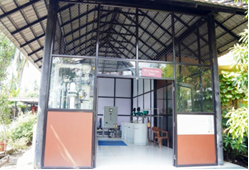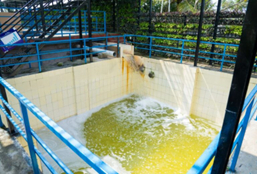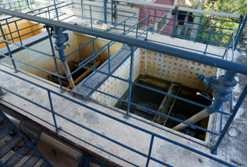Amrita Vishwa Vidyapeetham: Sustainable Water Management & Pollution Prevention 2024
Last Updated: December 12th 2024
Aligning with the United Nations Sustainable Development Goal 6, “Ensure availability and sustainable management of water and sanitation for all”, in 2024, Amrita Vishwa Vidyapeetham advanced its commitment to sustainable campus water management through a comprehensive strengthening of wastewater treatment and reuse systems. The institution formalised contaminant-control procedures for construction and campus operations, expanded stormwater and erosion controls, and scaled community education and operational monitoring initiatives. Building on prior investments in Sewage Treatment Plants (STPs), zero-pit sanitation, and regular groundwater testing, Amrita implemented a suite of technical, operational, and governance measures in 2024 that together reduce freshwater demand, lower pollution risks to on- and off-campus aquatic ecosystems, and enhance resilience to accidental releases.
- Wastewater treatment & reuse: Continued operation of multiple STPs with a combined design capacity of 1,400 m³/day, with long-term average treatment around ~1,300 m³/day. Treated effluent is routinely reused for toilet flushing, landscape irrigation and arboriculture. Amrita maintains a campus target of ≈70% potable water offset via reuse and continued progress toward that goal in 2024. Typical treated effluent quality remains high (BOD routinely ≤ 3 mg/L in upgraded units), supporting safe non-potable reuse.
- Sanitation upgrade: Campus fully maintained as a zero-pit toilet system with all wastewaters directed to treatment infrastructure.
- Operational inspection & maintenance: The periodic inspection programme (initiated April 2023) and a log-card system continued through 2024 — covering pipelines, tanks, coolers, pumps and taps — reducing leaks and enabling faster corrective action.
- Infrastructure identification & asset control: Asset labelling and barcoding was extended across critical equipment; CCTV surveys of sewer and stormwater networks were completed for legacy and newly installed lines. Integration of barcode records into a central asset database began in 2024.
- Pollution prevention systems: Grease traps, segregated pumping for different waste streams, and stormwater pre-treatment (settling, silt barriers) were installed/expanded across food service and maintenance zones. Spill response procedures and spill-kits are in place across critical operational areas.
- Education & behaviour change: Campus campaigns in 2024 reinforced correct disposal practices, spill reporting, and water conservation; kitchen and catering contractors adopted grease management protocols.
- Construction & contractor controls: For all major works in 2024, contractors were required to submit Environment, Health & Safety (EHS) plans / Construction Safety & Environment Management Plans describing environmental risks, control measures, monitoring arrangements and incident notification procedures; on-site EHS supervision and routine inspections were enforced.
1. Wastewater & reuse management
- STP operation and expansion planning: Amrita continues to optimise existing STPs (aerobic/activated sludge processes) for high removal efficiencies and nutrient management. Work carried forward in 2024 included process tuning, desludging schedules, and operator training. A larger advanced STP (planned capacity expansion) remains scheduled for upcoming years to match campus growth.
- Quality assurance: Routine in-house and third-party laboratory testing of treated effluent and nearby groundwater points continued in 2024 (microbial, physico-chemical and heavy-metal panels). Test results are recorded and trended to detect deviations early.
- Safe reuse practices: Treated water is used only for designated non-potable applications (toilet flushing, landscape irrigation, cooling-tower make-up where permitted). Distribution lines for recycled water are clearly labelled and physically segregated.
2. Construction, contractor and high-risk works controls
- Contractor EHS requirements: All contractors performing major or high-risk works must submit an approved Construction Safety & Environment Management Plan (CSEMP) or equivalent, describing environmental risk assessments, erosion & sediment control, containment measures for temporary fuels/chemicals, monitoring, and notification procedures for any incident.
- On-site supervision: Projects deploy on-site EHS officers and regular superintendent inspections; high-risk minor works require pre-work Work Method Statements and sign-off before starting.
- Buried services & permit-to-dig: Subsurface utility surveys, permit-to-dig protocols, and safe excavation practices are enforced to prevent accidental damage to sewer/stormwater lines that could release contaminants.
3. Stormwater, erosion and sediment control
- Treatment at source: Where possible, stormwater is treated or attenuated on-site using biologically based features (swales, constructed wetlands, sedimentation basins and infiltration features) to trap sediment and reduce pollutant loads before discharge.
- Runoff management measures implemented in 2024: silt-control fences for construction areas; inlet protection for drains; sediment basins at major disturbance sites; and installation of debris separators and filters on critical drains. Permeable paving and reduced hardscape have been piloted in select zones to increase infiltration.
- Erosion monitoring & rapid response: In collaboration with campus environmental researchers and external specialists, Amrita in 2024 piloted a precision erosion-mapping approach (targeted monitoring of problem slopes, gullies and drain inlets) and introduced an incident notification workflow to rapidly mobilise sediment controls after heavy rains or construction events.
4. Hazardous materials, chemical & waste management
- Comprehensive hazardous materials controls: All hazardous chemicals, oils, paints and laboratory reagents on campus are managed under documented procedures for storage, containment, inventory control, handling and disposal. Purchase controls and labelled storage reduce spillage risk.
- Waste segregation & regulated waste disposal: Clinical, chemical and other regulated wastes are segregated, labelled and disposed of through authorised channels per applicable regulations. 2024 saw expanded training on chemical labelling and use of secondary containment for high-risk storage areas.
- Design measures to prevent cross-contamination: Fixed design choices — such as routing air-conditioner condensate and kitchen floor drains to appropriate sanitary sewers (and not to stormwater) — were formalised in project standards and enforced during 2024 retrofits and new works.
5. Spill prevention & emergency response
- Spill prevention planning: Spill-response plans, standard operating procedures for containment, and dedicated spill-kits were distributed to laboratories, fuel stores, workshops, and kitchens. Staff and contractor induction in 2024 emphasised immediate containment and reporting.
- Incident notification & investigation: A documented reporting chain for environmental incidents (near-miss through major spill) was used in 2024 to improve root-cause analysis and corrective actions; learnings are fed back into contractor supervision and design updates.
6. Marine & microplastic pollution reduction
- Single-use plastic reduction: In 2024, Amrita extended initiatives to reduce plastics on campus: single-use cutlery/utensil bans in catering contracts, guidance for sustainable events, refill stations, and campaigns to use reusable bottles/cups.
- Waste-to-resource & event planning: Sustainable Event Guidelines were promoted, and waste management plans were required for larger gatherings to avoid plastics entering drainage systems and waterways.
7. Monitoring, data & asset management
- Inspection cadence & log cards: The scheduled periodic inspections (introduced April 2023) were continued and refined in 2024; inspection logs are used to prioritise repairs and replacements.
- Asset labelling & central database: Asset barcoding and labelling completed for major equipment; integration into a central maintenance management system started in 2024 to enable predictive maintenance and a single source of truth for asset condition.
- Diagnostics for underground networks: CCTV surveys of sewer and stormwater mains were completed for legacy and new installations to locate defects and leaks.
Metrics & performance indicators (2024 highlights)
- STP combined design capacity: 1,400 m³/day; long-term average treatment ≈ 1,300 m³/day.
- Reuse target maintained: ≈70% campus non-potable water offset target (progress continued in 2024).
- Treated effluent quality at upgraded units: BOD ≈ 3 mg/L (typical after advanced treatment).
- Number of contractors EHS plans reviewed and approved (major projects in 2024): All major projects required CSEMP submission; 100% compliance for projects above threshold.
- Asset labelling: All critical equipment labelled; barcode integration to central system initiated (ongoing).
Governance, training & community engagement
- Contractor & staff induction: 2024 strengthened EHS induction modules for contractors and operational staff with specific modules for spill response, stormwater protection and chemical handling.
- Student & staff awareness: Campaigns and training sessions on responsible disposal, water conservation, and reporting were run across campuses; sustainable event guidance rolled out to student unions and administrative units.
- Research & collaboration: Amrita’s environmental research groups collaborated with operations to trial precision erosion mapping and targeted remediation techniques.
Gaps identified & next steps (priorities for 2025)
- Complete central integration of asset barcodes into the Computerised Maintenance Management System (CMMS) to enable predictive maintenance and faster incident response.
- Scale ecological monitoring: expand the 2024 pilot of ecological water-body monitoring to a full programme across sensitive water bodies, with fixed monitoring locations, biological and physico-chemical parameters, and seasonal sampling protocols.
- Expand stormwater treatment at scale: increase use of bioswales, constructed wetlands and infiltration basins during new landscape projects and retrofits.
- Full implementation of advanced STP expansion aligned to campus growth to guarantee treatment capacity and maintain reuse targets.
- Zero-plastic events target: move toward zero single-use plastic for official campus events via supplier contracts and event permitting.
- Continued contractor oversight: refine contractor performance KPIs tied to environmental outcomes (sediment control, spill incidents, compliance with CSEMP commitments).




